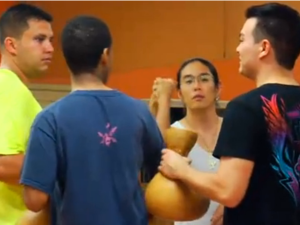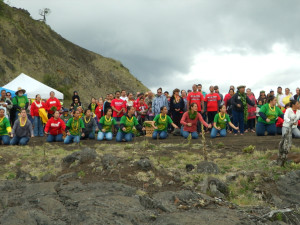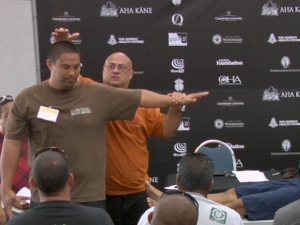The Office of Hawaiian Affairs and the Department of Public Safety give families a cultural-based alternative in the criminal justice system as they define the meaning and purpose of Puʻuhonua.
Ua mālama ʻia kahi hālāwai e OHA no ke kōkua ʻana i ka Department of Public Safety me nā manaʻo e kōkua i nā poʻe Hawaiʻi ma nā hale paʻahao.
“Noi ʻia ka papahana e hōʻike i ka hiki ke loaʻa ka puʻuhonua ma ka ʻoihana kalaima kaulike,” wahi a Ted Sakai, ke Poʻo o k Department of Public Saftey ma Hawaiʻi.
No ka Hawaiʻi, ua hiki ka poʻe a pau ke hele i ka puʻuhonua no ka palekana me ke kōkua. Manaʻo ʻo OHA lāua ʻo DPS he manaʻo maikaʻi kēia no ka pono o ka poʻe Hawaiʻi.
“ʻAʻole maikaʻi ka hoʻokaʻawale wale ʻana i ke kanaka.” wahi a Kamanaʻopono Crabbe, ka Pouhana o OHA. “He mea nui ka hoʻohana ʻana i ka moʻomeheu i ʻike ai kēia mau kānaka, ua pili ka pilikia i ke kaiaulu; ʻaʻole iā lākou iho wale.”
ʻO kahi pahuhopu o kēia hālāwai, ʻo ia ka loaʻa o nā ʻoihana i ʻike i ka maikaʻi o ka hoʻohana ʻana i ka moʻomeheu, e like me ka Women’s Correctional Center ma lalo o ka Puʻa Foundation.
“Komo nā wāhine ke ʻike lākou i ke kākoʻo mai ke kaiaulu. Ke pono ko lākou nohona ponoʻī, pono pū ko lākou ʻohana a ʻano wahine,” wahi a Toni Bissen, ke Poʻo o Pūʻā Foundation. “Ua ʻike nā wāhine i ua mea ʻo ka puʻuhonua. Hilinaʻi lākou i ka manaʻo o ka hiki ke pono ko lākou nohona ma muli o ke kākoʻo o ke kaiaulu. Makemake lākou e pono; he mea kēia e komo like ai kākou a pau.”
“Makemake au e hoʻomau i kēia kūkā ʻana me nā poʻe alakaʻi a me nā poʻe i hoihoi i kēia manaʻo i mea e kūkulu ai i pāhana maikaʻi no ka hōʻike ʻana i ka ʻaha ʻōlelo,” wahi a Ted.
“Ua ʻike kākou i ka waiwai o ke kaiaulu. He hoʻomaopopo i ke kanaka, kona nohona a ala e hele ai. No laila, he hana lōkahi kēia,” wahi a Kamanaʻopono.
The Office of Hawaiian Affairs recently hosted a summit to assist the Department of Public Safety in a deadline to address issues regarding Native Hawaiians in the criminal justice system.
“The legislature passed a law that asks the department to develop- provide a report on how we can use the puʻuhonua in the criminal justice system,” says Ted Sakai, Director of The Department of Public Safety in Hawaiʻi.
For Hawaiians, a puʻuhonua is a place of refuge where anyone, even those who have done wrong, can seek safety and guidance. OHA and DPS believe this could be a healthy alternative while looking at the greater good of our Hawaiian people.
“The archaic manaʻo or philosophy of locking up and throwing away the key is not an option anymore,” says Kamanaʻopono Crabbe, CEO of The Office of Hawaiian Affairs. “I think what is most important about the cultural foundation that these men and women, these ʻōpio understand that this problem isn’t only an individual problem, it’s community, it’s societal.”
As a mission to move forward as a community, one of the goals of the summit was to bring in people and organizations who have seen the reality and success of cultural connection, such as the Women’s Correctional Center under the Pūʻā Foundation.
“The women are engaged to be able to see that there is hope for them to transform and therefore, by healing themselves, they heal their families. They can be better women, they can be better wives, they can be better mothers,” says Toni Bissen, Director of Pūʻā Foundation. “So the women have embraced this overarching understanding of what a puʻuhonua is. They’ve engaged in the hope that there is hope there for them that people are there, that the community does care for them. They want to transition, they want to be a part of the solution; it’s that kākou ability for all of us to be a part of the solution.”
“I would like to continue the discussion even after today, not only with the people who are educating us but also the people who are also very interested in the concept and I’d like to work together to develop a plan that we can take to the legislature together,” says Ted.
“We are at the point in our community, where we have a higher consciousness. We have a greater awerness of who we are, where we are, where we come from and where we would like to go. And because of that, it’s a collective mana,” says Kamanaʻopono.




